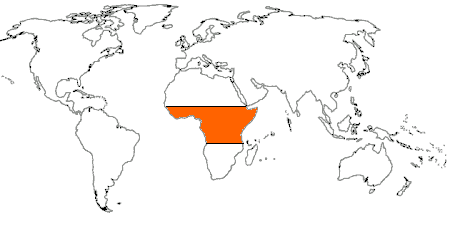
Out Of Africa
Fossil evidence suggests that modern humans evolved in Africa by 100,000 years ago and soon spread from there to West Asia. They may have reached East Asia and Australia by 60,000 years ago, but probably only arrived in Europe almost 40,000 years ago. Their migration into the Americas was probably more recent still. (The Book of Life. Ed. S.J. Gould 1993)
The Human Migration from Africa
 The power that drives almost all life on earth ultimately derives from the radiant energy of the sun. On this planet, the axis of its daily rotation is such that the maximum of solar energy is received in the equatorial region, and the minimum at the poles. Consequently there is much more solar energy available in equatorial regions for plant photosynthesis than at the poles, and plant growth in these areas - given adequate water and nutrients - is the greatest in these regions. And because plant growth is greatest in these regions, plants can support the largest numbers of grazing animals, and in turn the largest numbers of predators.
The power that drives almost all life on earth ultimately derives from the radiant energy of the sun. On this planet, the axis of its daily rotation is such that the maximum of solar energy is received in the equatorial region, and the minimum at the poles. Consequently there is much more solar energy available in equatorial regions for plant photosynthesis than at the poles, and plant growth in these areas - given adequate water and nutrients - is the greatest in these regions. And because plant growth is greatest in these regions, plants can support the largest numbers of grazing animals, and in turn the largest numbers of predators.
In general, all other things being equal, any life form will have maximum idleness in the tropics, and idleness will fall the further it moves from the tropics, ultimately falling to zero at some high latitude. The most idle forms of life are likely to have the greatest geographic range north and south of the equator, with the least idle restricted to equatorial regions.
Tropical regions probably provide the best environments for the origin of any plant or animal, humans included. If the earliest hominid life was restricted to tropical Africa for many millions of years, this suggests that hominid life was not very idle, and hominids could not tolerate life at higher latitudes, where food was less abundant, and temperatures lower.
Given a tropical region rich in fruits, seeds, roots, and many varieties of small animals, it seems entirely plausible that early humans lived as hunter-gatherers, using very simple tools. Equally probably, given high air temperatures sustained throughout the year, they were mostly unclothed.
When such untooled and unclothed early humans in Africa moved north or south of their equatorial homelands, they would have found that life became progressively more difficult. Not only did air temperatures fall, increasing body heat losses that required compensatorily higher calorific food intakes, but also food in the form of plants and animals grew scarcer too. As they moved northward, their idleness fell as they had to work harder and harder to sustain themselves. At some high latitude, these untooled humans became unable to sustain themselves, and were thus constrained to the lower latitudes within the African continent.
At the high latitude frontiers of their geographical range, where idleness was low, there would have be a strong incentive to innovate, to develop clothes and shelter and tools that made life easier. And as their idleness increased, so they were gradually able to extend the frontier northward and southward within the African continent.

In the south, expansion stopped at the oceans. But in the north, the gradual movement continued. And once the narrow passage1 into the Middle East between the Mediterranean and Red seas had been found, humans moved rapidly east into the Arabian peninsula, Persia, and then south into India and South East Asia, using technologies they already had. And the further south they moved in south East Asia and Indonesia, the nearer they approached the equatorial conditions of their African ancestors.
It was only when these vast new territories had been occupied that the northern frontier began to be push northward, rising through Asia, spilling into Europe, and finally hopping across from Kamchatka into Alaska in North America, and moving rapidly down into South America, and discovering in equatorial Amazonia another tropical homeland, where they could again dispense with most of their technologies, and revert to a simpler, barely-tooled, unclothed existence.
The Seasons of Northern Latitudes
In its annual orbit of the Sun, the axis of the spinning planet Earth is tilted at a small angle - 23 degrees - perpendicular to the orbital plane. And so, at any latitude, instead of there being a constant daily solar power input, it varies through the year. At the equator, this variation is the least, and it becomes more and more marked further and further north or south of the equator, causing hot summers and cold winters, until at the poles through which the axis of rotation passes, there are winters when the sun never rises and summers when it never sets.
The result is that, in mid latitudes, it is during the hot summers that plants grow and reproduce, and grazing animals multiply, while in the winter growth and reproduction slow or halt. Some animals respond by migrating to high latitudes in the summer, and returning to lower latitudes in winter. Others respond by busily stocking up with food during the abundant summer, and idly hibernating through the winter.
Humans followed both strategies. As nomads, they either ventured north in the summer, and returned south in the winter. Or else they overwintered in the north, living on food stored up from the summer months.
It was perhaps the nomads who 'domesticated' animals. For in their nomadic journeys they were probably accompanied by equally nomadic horses and cattle. Rather than carry their various tools themselves, they may have captured some of these animals, and loaded the burden onto them, recapturing them and unloading them when they reached their common destination. Or again, when some obstruction barred the normal course of migration, humans took on the role of shepherds and guides for the migrating animals. And so both gradually became dependent upon each other: the migrating animals being assured of safe passage and good grazing, and the humans acquiring beasts of burden.
And those humans who remained static, overwintering at one spot, had to learn collect sufficient food to last through the relatively barren winters, and build themselves warm shelters. And it was perhaps the requirement of building up a stock of food that produced agriculture. Rather than rely on the uncertain natural produce of the land, humans began to notice which ones flourished in what conditions, and to recreate those conditions, and gather and plant their seeds, tend and protect the plants from grazing animals, and thus ensure a far greater produce than from uncultivated land, sufficient to last the winter. And they learned how to preserve foods over winter by drying them, smoking them, or storing them in honey or salt or vinegar. And because their farms attracted grazing animals and birds, they built hedges and fences to keep them out, and encouraged predatory dogs and cats and falcons to defend their crops. And they constructed calendars which would tell them when winter and summer would come. In all these things they had to be far more disciplined than their tropical cousins.
And as they developed and perfected food preservation, agriculture, building, toolmaking, and trade, they in turn became able to gradually extend their range further and further north. Yet the further north they moved, the thicker their clothing had to become, and the more substantial their dwellings. The result was that, even with the assistance of many tools and techniques, the northernmost peoples lived busier lives than their tropical cousins.
The African Civilization
It is sometimes asked why Africa did not develop an 'advanced' civilization, with agriculture and buildings and roads and laws. The answer is that tropical Africans simply had no need of such things. They had no need of clothes and food preservatives, or of stone buildings and farms. In their warm abundant environment, they had everything they needed, all year round. And when 'advanced' humans reached the tropical Indonesian islands and Australia, or the tropical Amazonian forests of South America, they often reverted to a simpler and more appropriate 'African' hunter-gathering lifestyle. Hard-working, 'advanced' civilization, with its high technology, its trade, its discipline and law, was a way of living - evolved by necessity - that enabled humans to live in progressively higher latitudes. To call such civilization 'advanced' is merely to make a virtue of necessity.
For the same reason, while stone or timber buildings were very valuable in cold high latitudes, and the stone or copper tools needed to build them accordingly valuable, these things were of little value in the warm tropical regions where a few palm leaves draped over some branches sufficed for a shelter. There is nothing inherently virtuous about raising stone buildings, or using copper axes, or wearing woollen trousers.
Put another way, if humans one day inhabit colonies on Mars, living in closed stations, with bottled oxygen supplies, and space suits, would these colonists ever start wondering why Earth had never developed a 'high culture' of bottled oxygen, recycled urine, and space suits, and conclude that early Earthmen must have been 'backward'?
Other explanations for the failure of Africa to develop an 'advanced' civilization describe Africa more as a hostile environment than a tropical Eden, in which any number of diseases proliferated, decimating both humans and livestock. Yet if Africa offered such a hostile environment, how come humans and their ancestors survived there for several hundreds of thousands of years, and never developed any immunity to these diseases? One answer, perhaps, is that a great many of these diseases were not indigenous but were imported, and only arrived in Africa along the migration and trade routes which gradually extended to encompass the globe. If the malaria mosquito or the bilharzia snail or the tsetse fly were originally confined to some remote regions of the world, the to and fro of trade and emigration and nomadic life may have, by slow stages, brought them to Africa, where the environment was more conducive to every kind of life than any other.
There must have been a considerable human culture in the Africa from which humans radiated. It just wasn't one with large stone buildings, metal tools, written languages. But it had to be one in which the deepest foundations of all human cultures were formed, and of which every other human culture is a subset. For it must have been in Africa that the first cooperative human societies developed, the first languages, the first social moralities, the first tools. Without that primary social cohesion, humans could never have undertaken the arduous task of expanding out of Africa into the high latitudes of the world. The African civilization didn't create pyramids and skyscrapers: it created family, friendship, compassion, courage, trust, honesty, and all the essential virtues of ordinary humanity which are the foundations of all successful human enterprises.
1. Perhaps the importance of this region, the birthplace of several religions, lies in the fact that, after sea levels rose at the end of the last Ice Age, it was the only land bridge from Africa to the Eurasian continent.
